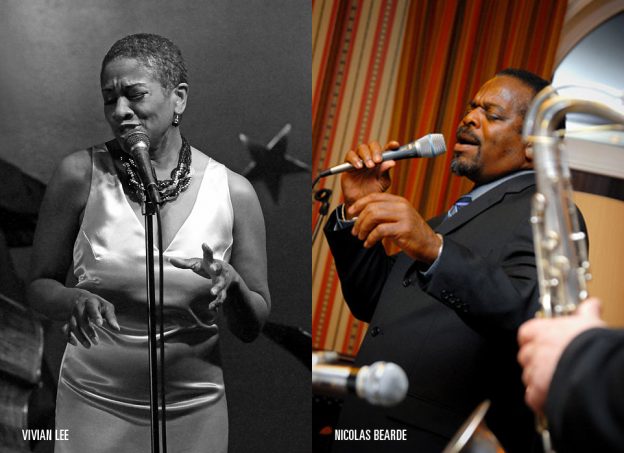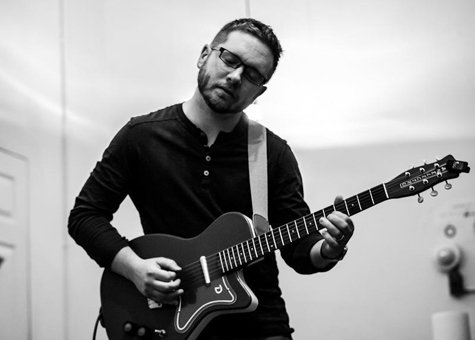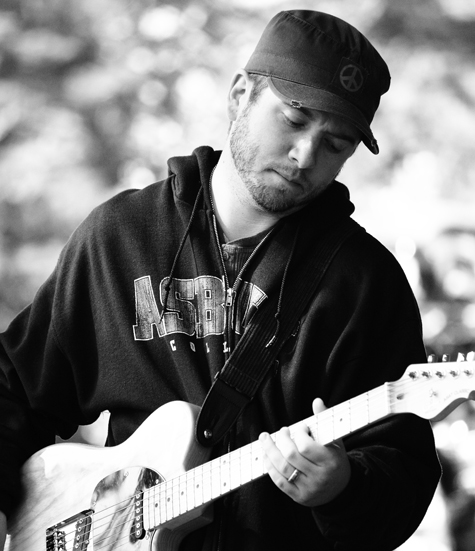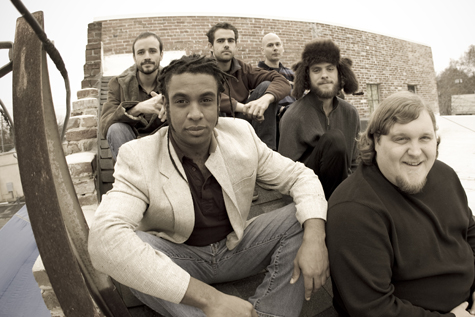The Crocker Art Museum’s Summer Jazz Series is starting up again this month, and you can expect to find soulful live jazz performances at the museum every third Thursday between now and the end of September. Jazz Night at the Crocker is Sacramento’s longest-running summer jazz series, and this year, the series will feature performances by a lineup of musicians based on recommendations by Capital Public Radio’s jazz music director, Gary Vercelli. The first evening of jazz will be on June 15, with Nashville-raised artist Nicolas Bearde. On July 20, Sandy Cressman will entertain museum-goers with Brazilian-inspired jazz music and rhythms. On Aug. 17, California’s Ray Obiedo will enchant the audience with his smooth Latin-influenced compositions. Jazz musician Vivian Lee will bring the series to a close on Sept. 21, so you won’t want to miss the opportunity to catch this Sacramento artist’s captivating and unique stage performance. Before the show and during intermission, food, wine and picnics will be available for purchase at the Crocker Café (by Supper Club). The concerts start at 6:30 p.m. All ages are welcome. Tickets are available at Crockerart.org.
**This write-up first appeared in print on page 10 of issue #241 (June 5 – 19, 2017)**
Ross Hammond discusses his new album with The Ross Hammond Quartet and His New Muse
Interviewing Ross Hammond on a Friday afternoon while his wife was out of town meant a secondary task of taking his 18-month old daughter, Lola, for a stroll around the 17th and L block of Midtown.
Lola led the way, while Hammond and I discussed his upcoming Ross Hammond Quartet record due this month. As we strolled and pointed out flowers, dogs and trucks (Lola loves trucks and buses), it became apparent the little blondie was responsible for changes and inspiration in her father she’ll not understand for years. The record, Adored, and Hammond’s artistic growth displayed on the album would not be possible without her.
Our walk began in the alley outside Old Soul Coffee. We did roughly three laps of the block and if we stopped the question was posed, “Lola walk?” In answering, Lola formed her first contribution to the interview tape “Lola walk.” Many of Hammond’s responses were fractured with quick “stay close” requests, but we eventually got down to brass tacks. The immediate information to hash out: Who are the players in the Ross Hammond Quartet?
The ensemble came together mostly through the intricate web of the jazz scene involving booking, travel and of course, collaboration, although Hammond first came to know each member from owning their albums. Whether on stage or in the studio, he said he had several surreal moments that left him pondering, “How did I get here?” The Quartet comprises Hammond on guitar, Vinny Golia on saxophone, Steuart Liebig on contrabass guitar and Alex Cline on percussion. Hammond said he’d known Golia from booking him a gig at the Cool Cat Gallery on 24th–back when it existed–and Cline in a similar fashion. Cline is the twin brother of legendary guitarist Nels Cline, who’s currently playing lead guitar in Wilco. “It’s freaky, dude,” Hammond said regarding the Cline brothers. “They’re identical and both really tall.”
As for Liebig, “I don’t know how I met, Steuart… I guess through the scene.”
He played three to four gigs, including the In the Flow Festival in Sacramento last year, with the members, planting the seed for the quartet. After he’d enlisted the three musicians for a studio session in Los Angeles, the makings of an official ensemble came to fruition.
When it came time to name the project, Hammond was surprised by the other members’ suggestion of naming the quartet after him. At 34, Hammond is the youngest member of the group while the rest were born as far back as the ‘40s. It is a humble and impressive gesture coming from three renowned L.A. jazz musicians who have each had ensembles bearing their namesakes.
“For lack of anything better that’s what it is,” Hammond said. “I’ve never had a quartet before. I also feel like I couldn’t replace any of those guys and still call it the same thing.”
Recorded at Newzone Studio and engineered by Wayne Peet, the album was tracked in six hours with only a few songs needing alternate takes. It’s a feat that speaks to the veteran musicianship of Hammond’s quartet. Hammond would play the riff he had in mind for a song and the ensemble would offer a nod or “OK”–no further tutelage required. He said after each track, it was understood that it felt good and they would move on to the next song.
“Playing with these guys it’s just about staying on the wave,” he said. “You don’t have to give them much instruction at all. I think one of the instructions I gave Vinny was, ‘OK, as soon as this song starts you have to come in like an elephant,’ and that’s what he did.”
Adored is carved from a foundation of folk songs with the title track being a lullaby Hammond sings to Lola at bedtime. Hammond said three of the songs are lullabies he sings. After she’d go to sleep he would figure out the notes and write out the lullaby. The writing is at its most encrypted on “Maribel’s Code,” in which the melody is an intervocalic code built from Lola’s initials: LMH.
“Most of the stuff I write has either a dedication or an idea, be it political or romantic,” Hammond said. “I’m never just like, “oh this is a cool riff, I’ll call it…’”
Three years ago when I first interviewed Hammond, he shared a similar sentiment. The inspiration behind the album title An Effective Use of Space came from a saying his wife frequently used. He said it’s one she still uses to this day. Hammond listed his wife as still his deepest muse, but the birth of his daughter is the primary source of inspiration behind Adored.
The immediacy of the recording is palpable, but it’s done in maturity. Hammond said the difficult task in preparing the music was giving the songs a collected feel, but without being united to the point of bleeding the songs together. Adored roars in, spastic and angry, with “Adored” but as “Sesquipedalian” mellows out it introduces the soft lullaby of “She’s My Little Girl.” Consider the album to be much like Hammond’s day-to-day with Lola; awake at 6 a.m. and full of energy, a settling in period, a mid-day walk with small fits of exuberance and crankiness, a lullaby for a nap or the night’s tuck-in. It is all lovingly expressed in the sea changes of Adored.
“Alex [Cline] told me he doesn’t think you mature as a musician until after you’ve been a dad,” Hammond said. “The gist of it was you stop trying to impress people and focus on filtering this feeling you have and this beautiful thing and turn it into a song. Your muse is different. The goofy songs aren’t there anymore. Having a kid forces you to grow up and you grow up in everything. If anything it’s more purposeful now.”
With the particulars of the album discussed and rocks and leaves in our pockets courtesy of the tyke, Hammond asked Lola, “Wanna go swing? Lola swing?” She offered her second sentence of the afternoon; a sharp “Lola swing.” With that, they strapped into a bicycle and road off to the park.
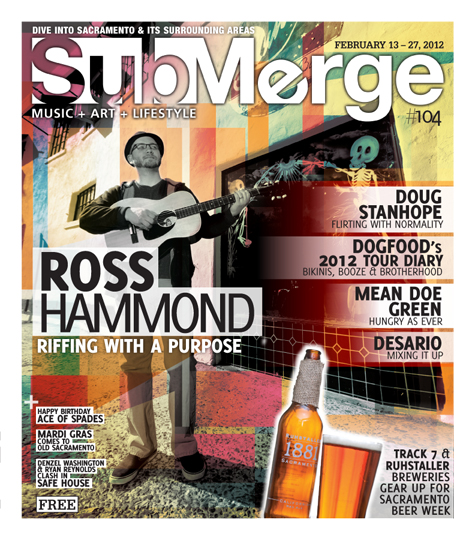
Adored by The Ross Hammond Quartet will be available Feb. 27, 2012. You can preorder it now at Rosshammond.bandcamp.com/album/adored and also listen to the title track. Hammond and co. will throw a CD release party on the very day of its release at Luna’s Café in Sacramento.
Ross Hammond and the Tao of Improvisation
At this year’s SXSW, Ross Hammond, performing with Teakayo Mission, put his rockist touch on the traditional hymn, “Let Us Go Into the House of the Lord,” leading a 14-minute tour of the heavenly kingdom. The live recording sounds as though he and his band mates reached nirvana; but for Hammond, this was just another night of performing in one of his many side projects.
It is tough to say why I feel this way, but the guitar has always been a spiritual instrument in my mind. Perhaps it is images of Jimi Hendrix kneeling in a prayer position, conjuring flames from a burning broken instrument, or the intoxicating feelings that come from Eddie Hazel’s 10-minute guitar soliloquy on Funkadelic’s “Maggot Brain.” A guitar is especially powerful when improvisation is introduced, allowing a guitarist to operate on instinct and inspiration—it is in these delicate moments that musicians seem touched by a divine muse.
Pulling the pomp from these circumstances, such musings can be reduced to just another good night for improvisational jazz—a scene that is garnering some attention in Sacramento. Ross Hammond has been operating within the limitless art form for over a decade, dividing time between improvisational groups, working as a sideman for singers and songwriters, teaching private lessons and curating local jazz shows. Some of his current projects, whether as a leader or session player, include RACE!!!, Teakayo Mission, V-Neck, Lovely Builders and Joaquin’s Night Train. Even with such a prolific resume, he’s reluctant to be dubbed torchbearer for the scene. “A lot of these projects that I’m playing in aren’t mine,” Hammond said. “There’s a lot of passing the leader title around in different projects. Usually a new project is from meeting someone new that’s into a similar idea or finding a new concept about how to present your music.”
Even in the most possessed thralls of improvisation, an artist cannot reach this higher ground without an intense dedication to the craft and community—one monk can’t run a monastery. Hammond views his eagerness to continually invite new musicians into his circle part of this ideal. “Playing with all kinds of different musicians and styles keeps you sharp,” he said. “That’s really the whole idea, in being able to play as much as I can in as many styles as I can.”
Hammond’s predilection for an unabashed marriage of style and technique are the principles for his latest solo record, An Effective Use of Space, a title penned by his wife. “It’s a phrase [she] likes to use when we talk about how things should be arranged in our house,” he said. “I’m sure someone could make a good musical meaning for it too. But it was more of a title that was given after the fact.”
Essentially, his wife has unwittingly helped this writer do just that, as his album suggests jazz feng shui. In a traditional sense, feng shui is an ancient Chinese system of aesthetics for improving ones life through placements of positive energy, but Hammond’s feng shui comes from his guitar-plucking intuition. The record also features several stylistic choices that require delicate placement.
[audio:Heaven Was Getting Crowded.mp3]
Hammond occasionally deviates from his signature sound to pose dedications to friends and family. One of his favorite songs is “Heaven Was Getting Crowded,” which features his recently departed grandmother—Hammond recorded her delivering this joke during her final stay in the hospital. “I wanted to get a recording of her telling her favorite joke, so that’s pretty much how it came out,” he said. “She was a very loving and supportive lady, and she loved to make people laugh. She would tell us and the doctors and medical staff jokes up to her final days.” Without overshadowing the recording, he supports his grandmother’s joke with a bittersweet mood created from solo electric and lap steel guitar loops. “The song is meant as a way to remember her jovial side,” he said.
Once again, I recall Hammond’s SXSW recording. It is as though his guitar is in deep meditation, yet there’s an unspoken connection with his band mates. The spiritual is the constant, while the exploration of a deeper understanding is ritually being sought throughout the performance. “I try to communicate whatever I’m feeling in the moment,” Hammond said. “That obviously has some day to day changes, but there are some parts of my personality that are pretty much constant.” Originally from Lexington, Ky. and raised in the church, Hammond’s spirituality is connected to his guitar playing. “I think most improvisers are that way,” he said. “You should be able to get an idea of what a person is feeling by listening to them play. I think that’s what keeps improvised music honest. But there’s also the factor of what your other band mates are doing. So, it is definitely a balance of trying to get across what you feel while still listening to what’s going on around you.”
The practice of meditation in Eastern religions holds relevance to the improvised jazz performer. Obtaining Zen through meditation involves intense mental stamina as a person directs awareness toward breathing or counting until he or she establishes a trance state. Improvised music shares principles with meditation, as the beat is the groundwork for the journey that comes from reacting to your group and the impulses you feel in the moment. “It’s like you are an antenna that is channeling the music from somewhere else,” he said. “When I play, I’m definitely not thinking about scales or keys. There’s an old adage that says if you are thinking when you play, then you’re gonna muck it up.” Once again, Hammond likened it to his personal experience of participating communally in church, “I think that is a very spiritual thing, because in that sense the music is something that is bigger than just me and whoever I’m playing with. It’s definitely greater than the sum of its parts. I think it’s a similar feeling as being in church, or meditating or whatever else people do to escape. When you are improvising it’s a timeless feeling in that it’s hard to tell if the song you just played was five minutes or 45 minutes.”
Hammond stresses that, though time loses its relevance while performing and the transcendental progression is intoxicating, it is important to hold dear to your purpose. For Hammond, creating is far beyond notes on staff paper, matching scales to chords and counting beats. He spoke with restraint, worried he’d sound too “new age-y,” relating that he created “to convey a sense of unity and harmony in the world we live in.”
Finally, I asked Hammond if he thought his style of improv-jazz was less intimidating than most jazz because of its focus on the guitar and crafting soliloquies. He resisted my hypothesis stating, “I don’t see jazz artists like John Coltrane or Pharoah Sanders being that much different than Pete Seeger or Bob Dylan,” he said. “They are all trying to convey a message through their music. That’s the important part. I think at this point jazz just means ‘not pop.’ Just play what you are feeling. That’s where the real music lies.”
What’s More American Than Apple Pie?
Sacramento-based Izabella is set to have their CD release party for their third album, Drugs and Apple Pie, at Marilyn’s On K April 11, 2009. Politically inspired, the album is a product of the election, and a reflection of the supposed positive change that some feel has yet to materialize in the fledgling Obama administration. Now playing keys for Izabella, Jeff Coleman spent last campaign season as a deputy field director for Obama in New Mexico.
“The album is a comment on the bullshit we’ve all been through the last eight years,” lead guitarist Sean Lehe said from a thrift store in Provost, Utah, where he shopped for a Mad Hatter costume for the Alice in Wonderland-themed gig they had in Boise the next night. This is their third album in just more than two years, a “reflection of a young band trying to pull it together in today’s day and age,” Lehe said.
Drugs and Apple Pie comes from the lyrics in the second song on the album, “Bittersweets,” and though the album has political undertones, there is plenty of the band’s specialty—jam rock fused with funk, reggae, bluegrass and jazz. Or, “Norcal rock,” as Lehe described it.
While four of the group’s members claim Sacramento as home, another is from Chicago and the other from San Luis Obispo. “The six of us have a lot of history together,” Lehe said. “We sort of coalesced out of a number of different bands.”
And their musical style reflects that. At shows, they’ll cover the Beatles, Dylan, 2Pac and Ginuwine. They’re influenced by what Lehe calls “pop music from the last 40 years” such as Michael Jackson, Stevie Wonder, Led Zeppelin, Phish and the Grateful Dead.
To pull the album together, Izabella spent two weeks in early February recording in Cotati at Prairie Sun Studio. There, the six-piece found their “natural element,” and they worked with producer and engineer Oz Fritz, who’s worked with greats like Tom Waits, Iggy Pop, The Ramones, Herbie Hancock and countless other musicians.
“Everything was really green in Cotati,” Lehe said, explaining the band’s name, Izabella, “represents the feminine energy of creation—not to sound like a dorky-ass hippie.”
Feminine energy of creation? Izabella is also the name of a Jimi Hendrix song, but these guys are some dorky-ass hippies, and they know it. “Yeah, we don’t mind tie-dyes, and we like to watch girls’ hips when they hula-hoop,” Lehe said.
When they finished in Cotati, the band hopped in the Portabella, a 40-foot 1988 MCI Bus, for their tour of the West. They’ve meandered down the coastline and through the Rocky Mountains, playing Denver for St. Patty’s Day and then Boise. Their tour will take them to Sparks, Nev., then on to Chico and finally to Sacramento for the release of Drugs and Apple Pie, where Seattle’s Flowmotion will open for them. The band is confident Drugs and Apple Pie will bring success.
“We’re dropping one of the hottest records a Sac band has dropped,” Lehe said. “And I’ve lived in Sac a long time, so I can say that with confidence.”

